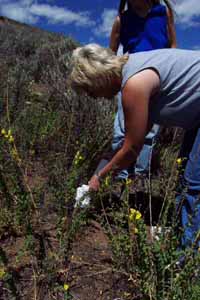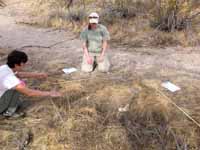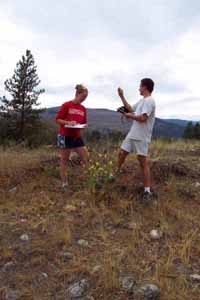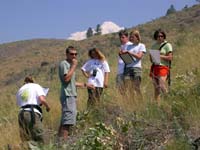Alien Plant Research Studies and Surveys
Pacific Biodiversity Institute’s staff and consultants have undertaken many projects that involve vegetation mapping, ecological assessments, botanical inventories and rare and invasive plant surveys. We are conducting a two year noxious weed survey for Seattle Public Utilities covering over 100,000 acres in western Washington. We have conducted invasive and rare plant surveys for Washington Department of Wildlife during 2006 and 2007.
Beginning in 2004, we have conducted vegetation community mapping and rare plant inventories in about 70 Washington and Oregon State Parks. Identifying and mapping invasive species infestations within these parks was a significant component of our project.
We have also conducted a multi-year invasive species mapping project in the Methow River Watershed to study weed dispersal along roadways and weed population dynamics.
We have conducted a multi-year assessment of the ecological condition of natural communities in the Sonoran Desert National Monument and adjacent areas on the Barry M. Goldwater Range (US Air Force) and Tohono O’odham Nation in Arizona. This project included extensive invasive species surveys along roadsides and xero-riparian areas and two subsequent studies of the factors affecting the distribution and abundance of native and alien grass species in the Sonoran Desert.
We have extensive expertise in field data collection, GIS and remote sensing technologies, plant distribution mapping and modeling, data management, map production, project management and technical writing. The following is a short synopsis of our experience and capability.
- We conducted a two year, intensive survey of noxious weeds in the three major watersheds that provide drinking water for the City of Seattle. In this project, Seattle Public Utilities is contracting with Pacific Biodiversity Institute to survey many of the disturbed sites, roads, power line corridors, gravel pits, wetlands and meadows within the watersheds for noxious weeds. We are also doing complete botanical inventories for some sites. More...
- We are conducting a long-term study of the distribution of invasive non-native plants in the Chewuch Watershed in the Methow Valley, Washington State. This study began in 1998 and has continued for nearly 10 years. We have created a baseline of data on non-native and native plant distributions in the watershed. Through repeated annual surveys and statistical analysis of the data, we have begun a long-term study of weed population dynamics. More...
- We completed botanical surveys of about 70 Washington and Oregon State Parks from 2004 through 2009. In these surveys we inventoried, vegetation community, non-native invasive plants and rare plants. More...
- We have conducted invasive plant, vegetation community and rare plant surveys in a portions of the Methow Wildlife Area (WA Dept of Fish and Wildlife) in 2006 and 2007.
- We conducted an intensive ecological assessment of a large portion of Mt. Spokane State Park for Washington State Parks. This includes surveys and recommendations about invasive plants, a very intensive survey of forest stand conditions, assessment of wildlife habitat conditions, forest health conditions, the development of treatment options for improving forest health, wildlife habitat and reducing wildfire risk. We have integrated all of this into a forest plan for the state park. More...
- We assisted the Methow Conservancy in conducting a landscape-level conservation needs assessment in the Methow Valley in 2005. We developed GIS data describing invasive non-native plant distributions, rare and endangered species distributions, sensitive area locations, and animal migration corridors. More...
- Assessment of the ecological condition of natural communities in the Sonoran Desert, 2002-2003 for The Nature Conservancy, US Dept. of Interior - Bureau of Land Management, US Air Force and the Tohono O’odham Nation. A comprehensive botanical inventory of 700,000 acres was completed as part of this project. This included mapping and analysis of the distribution of non-native, invasive plants and their effect on the ecological condition of natural communities. More...
- Ecological characterization, mapping and assessment of mountain native grass assemblages and xeroriparian areas in the Sonoran Desert, 2004-2006 for The Nature Conservancy, US Dept. of Interior - Bureau of Land Management and US Air Force. This included an analysis of the distribution and abundance of non-native, invasive grass species and the interaction of these species with native species. More...
- Our staff has ten years of organizational experience in providing scientific and technical support services, technical writing, landscape analysis, data management, project management, conservation planning, ecosystem analysis, and research. Some of our staff have over 30 years of experience in these activities.
- Our staff has extensive experience biology, ecology, vegetation mapping, designing and analysis of GIS and biological databases, ecological modeling, statistical analysis and advanced information management systems.
- We have one of the most comprehensive biological and spatial data libraries covering Washington State and the Pacific Northwest. This data library has extensive holdings of biological data, GIS data, and both historical and current satellite imagery and aerial photography.
- We have one of the most complete and up-to-date landscape analysis laboratories in the western North America, with the latest remote sensing and GIS hardware and software. Our staff members are considered world experts in landscape analysis using these tools.
- We have over ten years of experience providing scientific and technical support services in the Pacific Northwest and elsewhere. Pacific Biodiversity Institute has worked on over a hundred successful projects with many agencies and organizations around the world over that last ten years. We are recognized as one of the international leaders in the field of landscape analysis, conservation science and application of GIS to natural resource issues.
- We have extensive managerial experience in budgeting, scoping, and implementing vegetation mapping projects, landscape analyses, ecological assessments, conservation prioritization, data management, analysis, and report writing.
Our staff and consultants have conducted botanical inventories, invasive plant surveys, rare plant surveys, in numerous locations in Washington State and other parts of the western US. This includes:
- Rare plant and range condition survey of parts of the Naches Ranger District, Wenatchee National Forest.
- Rare plant and range condition survey of parts of the Entiat Ranger District, Wenatchee National Forest.
- Rare plant and range condition survey of parts of the Winema National Forest.
- Exotic plant studies and exotic plant surveys of the Chewuch Watershed, Washington.
- Botanical inventories and rare plant searches as part of Pacific Biodiversity Institute’s Wilderness Study program.
- Collection of forest ecology intensive plot data (including all vascular plant species), Wenatchee National Forest.
- Vegetation surveys and botanical inventory of North Cascade ecosystem for the North Cascade Grizzly Bear Habitat Assessment Project.
Selected Publications Related to Alien Plants
Morrison, P.H. in review. Convergence of Stressors on Protected Desert Ecosystems in the Border Region of Southwestern Arizona. In: Transborder Conservation between the U.S. and México: Binational Solutions to our Shared Problems. Univ. of Arizona Press.
Morrison, P.H. 2006. Invasive Species Account: Dalmatian Toadflax in Boersma, P. D., S. E. Reichard, and A. N. Van Buren. Invasive Species in the Pacific Northwest. Seattle and London: University of Washington Press, 2006.
Copyright © Pacific Biodiversity Institute



